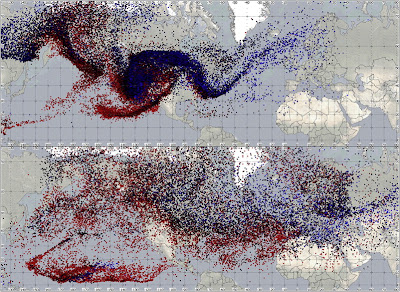It is a pay per view paper but you can find some better quality images at Ah, Mephistophelis.
G. Lujianiené et al., Radionuclides from the Fukushima accident in the air over Lithuania: measurement and modelling approaches. Science 2011. Pay per view.
Abstract
Analyses of 131I, 137Cs and 134Cs in airborne aerosols were carried out in daily samples in Vilnius, Lithuania after the Fukushima accident during the period of March–April, 2011. The activity concentrations of 131I and 137Cs ranged from 12 μBq/m3 and 1.4 μBq/m3 to 3700 μBq/m3 and 1040 μBq/m3, respectively. The activity concentration of 239,240Pu in one aerosol sample collected from 23 March to 15 April, 2011 was found to be 44.5 nBq/m3. The two maxima found in radionuclide concentrations were related to complicated long-range air mass transport from Japan across the Pacific, the North America and the Atlantic Ocean to Central Europe as indicated by modelling. HYSPLIT backward trajectories and meteorological data were applied for interpretation of activity variations of measured radionuclides observed at the site of investigation. 7Be and 212Pb activity concentrations and their ratios were used as tracers of vertical transport of air masses. Fukushima data were compared with the data obtained during the Chernobyl accident and in the post Chernobyl period. The activity concentrations of 131I and 137Cs were found to be by 4 orders of magnitude lower as compared to the Chernobyl accident. The activity ratio of 134Cs/137Cs was around 1 with small variations only. The activity ratio of 238Pu/239,240Pu in the aerosol sample was 1.2, indicating a presence of the spent fuel of different origin than that of the Chernobyl accident.Highlights
► Two observed maxima in radionuclide concentrations were related to air mass transport. ► HYSPLIT backward trajectories were applied for data interpretation. ► 7Be and 212Pb were used to study a vertical transport of air masses. ► The 134Cs/137Cs activity ratio was around 1. ► 238Pu/239,240Pu ratio was different from global fallout and Chernobyl accident.
It is obvious that Europe has not gone unscathed from this disaster, even if, so far, the amount of radioactive elements has been smaller than with Chernobyl - but then Lithuania is quite close to the infamous Ukranian former nuclear power plant. Also it is unclear how the long term effect of an uncontained source (and probably a much more severe disaster when the core hits the water table) will affect us all, let's not forget that Chernobyl was contained in a matter of months and that there was no policy of letting the radioactive materials scatter around, as is happening in Japan with the pretext of the economy and whether plutonium is totally harmless and what not.
Above: Fig. 1:
Particles spacing on 20 March, 2011 at 12:00 UTC (top) and on 27 March, 2011 at 18:00 UTC (bottom); shades of red indicate particles in the bottom layer, up to 3 km; black to dark blue indicate the middle layer, up to 6 km height; and light blue indicates the upper layer; the trajectories were simulated using the Lagrangian dispersion model (time of the particles release was on 12 March 2011). (For interpretation of the references to colour in this figure legend, the reader is referred to the web version of this article.)
Above: Fig.8:
An example of 72 h air mass backward trajectories ended at Vilnius sampling site at 19 UTC at 20, 500, 1000 m AGL on 29 January, 1997, on 06 June, 1999 and on 03 February, 2001 for 4 analyzed sectors (modified after De Cort et al., 1998).
I chose to post this last image because the color scale indicates soil contamination because of Chernobyl. Some of the reddest zones are the Chernobyl exclusion zone, which is not small at all, but anyhow much of Europe is in fact contaminated... and radiation is forever.
Update: full paper uploaded online HERE.
Update: full paper uploaded online HERE.


your welcome -- and now there sould be links to the full text (if they have not broken already) ... be seeing you!
ReplyDeleteThanks, Faust. I uploaded it to ZohoViewer (1 year stay), which I like much better than the attachment download method, specially because you can browse before downloading or even read it online.
ReplyDeleteBrokie linkie... sorry.
ReplyDeletehttps://viewer.zoho.com/docs/xIubi